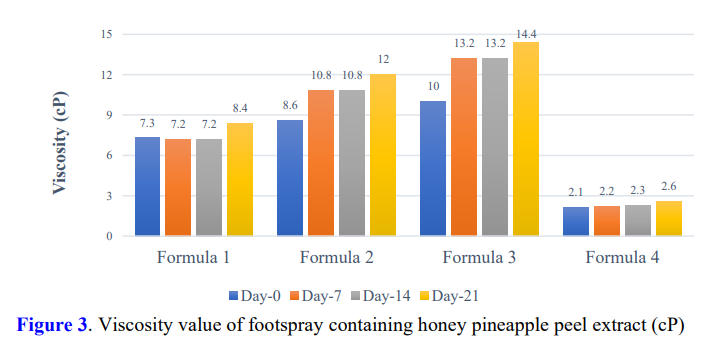Main Article Content
Abstract
Foot odor or bromhidrosis occurs due to the activity of bacteria that convert leucine in sweat into isovaleric acid which results in unpleasant odors. Honey pineapple skin (Ananas comosus [L.] Merr) is generally waste, whereas honey pineapple skin is known to contain antibacterial compounds. The aim of this study is to determine the potential of honey pineapple peel as an active ingredient in footspray based on the results of phytochemical screening and physical evaluation. Honey pineapple peel was extracted by maceration method using ethanol 70% then phytochemical test. Footspray preparations were made with various extract concentrations of 0%, 25%, 35% and 45% then tested for organoleptic, pH, specific gravity, viscosity, homogeneity, spreadability, and dry time during storage period of 0, 7, 14 and 21 days at room temperature. This study showed that honey pineapple peel extract contained flavonoids, tannins, phenols and alkaloids. The footspray has brown color with honey pineapple scent, pH of 5.71-6.37, specific gravity 1.05-1.09 g/mL, viscosity 7.2-13.2 cP, spreadability 6.67-7.60 cm, and the dry time is 4-5 minutes. Footspray containing honey pineapple peel extract with concentrations of 25%, 35% and 45% has a pH value that is safe for the skin, with good specific gravity, viscosity, homogeneity and spreadability, also stable during storage. Formula 1 (25% extract concentration) tends to be preferred because its texture is soft and not too sticky when applied to the skin when compared with formula 2 and 3.
Keywords
Article Details

This work is licensed under a Creative Commons Attribution-NonCommercial 4.0 International License.
References
- Afrina, Nasution, A. I., & Rahmania, N. (2018). Konsentrasi Hambat Dan Bunuh Minimum Ekstrak Serai (Cymbopogon citratus) Terhadap Candida albicans. Cakradonya Dental Journal, 9(1), 55–61. https://doi.org/10.24815/cdj.v9i1.9879
- Amananti, W., & Dairoh, D. (2021). Physical Properties and Antibacterial Activities of Spray Footsanitizer Combination of Coffee Seed and Ginger Extract with Variation of Stirring Speed. Proceedings of the 2nd Borobudur International Symposium on Humanities and Social Sciences, BIS-HSS 2020, 18 November 2020, Magelang, Central Java, Indonesia. Proceedings of the 2nd Borobudur International Symposium on Humanities and Social Sciences, BIS-HSS 2020, 18 November 2020, Magelang, Central Java, Indonesia, Magelang, Indonesia. https://doi.org/10.4108/eai.18-11-2020.2311705
- Ashfia, F., Adriane, F. Y., Sari, D. P., & Rusmini, R. (2019). Formulasi Dan Uji Aktivitas Antibakteri Sediaan Footspray Anti Bau Kaki Yang Mengandung Ekstak Kulit Jeruk Nipis Dan Ampas KopI. Indonesian Chemistry and Application Journal, 3(1), 28–33. https://doi.org/10.26740/icaj.v3n1.p28-33
- Balfas, R. F., & Rahmawati, Y. D. (2022). Skrining Fitokimia, Formulasi, dan Uji Sifat Fisik Sediaan Foot Sanitizer Spray Minyak Atsiri Sereh Wangi (Cymbopogon citratrus sp.). Jurnal Pharmascience, 9(1), 7.
- Farhamzah, Herli, A., & Mursal, I. L. P. (2021). Formulation and Antibacterial Activity Test of Foot Spray with Beluntas Leaf Ethanol Extract (Pluchea indica L.). IOP Conference Series: Materials Science and Engineering, 1071(1), 012013. https://doi.org/10.1088/1757-899X/1071/1/012013
- Halima, R. D., Yuliawati, K. M., & Kodir, R. A. (2020). Potensi Aktivitas Antibakteri Ekstrak Kulit Buah Nanas (Ananas comosus (L.) Merr.) terhadap Bakteri Gram Positif. Prosiding Farmasi 6(2), 5.
- Iswandana, R., & Sihombing, L. K. (2017). Formulasi, uji stabilitas fisik, dan uji aktivitas secara in vitro sediaan spray antibau kaki yang mengandung ekstrak etanol daun sirih (Piper betle L.). Pharmaceutical Sciences and Research, 4(3), 2.
- Musika, S., Pokratok, N., Pliankratoke, J., Khongla, C., Kupradit, C., Ranok, A., & Mangkalanan, S. (2021). Antioxidant, antityrosinase and antibacterial activities of fruit peel extracts. International Journal of Agricultural Technology, 17(4), 1447–1460.
- Namrata, Yash Sharma, Tripti Sharma, & Helix BioGenesis Pvt Ltd. (2017). Anti-Microbial, Anti-Oxidant Activity and Phytochemical Screening of Polyphenolic Flavonoids Isolated from Peels of Ananas comosus. International Journal of Engineering Research And, 6(9), 285–298. https://doi.org/10.17577/IJERTV6IS090176
- Rahmawati, I., Maulida, R., & Aisyah, S. (2021). Potensi Antibakteri Sediaan Sabun Cair Ekstrak Kulit Nanas (Ananas comosus L. Merr.) Terhadap Bakteri Staphylococcus aureus ATCC 25923. Jurnal Farmasi & Sains Indonesia, 4(2), 1–11. https://doi.org/10.52216/jfsi.vol4no2p1-11
- Rini, A. R. S., Supartono, & Wijayati, N. (2017). Hand Sanitizer Ekstrak Kulit Nanas sebagai Antibakteri Staphylococcus aureus dan Escherichia coli. Indonesian Journal of Chemical Science, 6(1), 63–66.
- Risnayanti, & Dalimunthe, G. I. (2022). Formulation Of Foot Spray Basil Leaf Extract (Ocimum africanum). Jurnal Farmasi, Sains, dan Kesehatan, 1(2), 9.
- Riyanta, A. B., & Febriyanti, R. (2018). Pengaruh Kombinasi Ekstrak Biji Kopi Dan Rimpang Jahe Terhadap Sifat Fisik Sediaan Foot Sanitizer SPRAY. Parapemikir : Jurnal Ilmiah Farmasi, 7(2), 247. https://doi.org/10.30591/pjif.v7i2.983
- Riyanta, A. B., Putri, A. R., & Susanto, A. (2020). Pemanfaatan Footsanitizer Spray Dapat Menumbuhkan Jiwa Wirausaha Bagi Siswa Smk Bisma Di Kersana Kabupaten Brebes. Jurnal Abdimas PHB, 3(1), 5.
- Santoso, J., & Riyanta, A. B. (2019). Aktivitas Antibakteri Sediaan Foot Sanitizer Spray Yang Mengandung Ekstrak Biji Kopi Dan Jahe. Parapemikir : Jurnal Ilmiah Farmasi, 8(1), 47. https://doi.org/10.30591/pjif.v8i1.1300
- Stevens, D., Cornmell, R., Taylor, D., Grimshaw, S. G., Riazanskaia, S., Arnold, D. S., Fernstad, S. J., Smith, A. M., Heaney, L. M., Reynolds, J. C., Thomas, C. L. P., & Harker, M. (2015). Spatial variations in the microbial community structure and diversity of the human foot is associated with the production of odorous volatiles. FEMS Microbiology Ecology, 91(1), 1–11. https://doi.org/10.1093/femsec/fiu018
- Susanti, E., Mulyani, S., Ariani, S. R. D., Utomo, S. B., & Antrakusuma, B. (2021). Phytochemical Screening of Honey Pineapple Peel Extract and Its Application as an Antibacterial Additive in Dish Soap Formulation. JKPK (Jurnal Kimia Dan Pendidikan Kimia), 6(1), 49–58. https://doi.org/10.20961/jkpk.v6i1.45444
- Wandono, E. H., Kusdiyantini, E., & Hadiyanto, H. (2020, November). Analysis of potential bioethanol production from pineapple (Ananas Comosus L. Merr) peel waste Belik District-Pemalang-Central Java. In AIP Conference Proceedings (Vol. 2296, No. 1). AIP Publishing.
- Waznah, U., Rahmasari, K. S., Ningrum, W. A., & Slamet. (2021). Bioaktivitas Ekstrak Kulit Buah Nanas (Ananas comosus (L.) Merr.) dalam Sabun Cuci Piring sebagai Antibakteri terhadap Bakteri Staphylococcus aureus. MPI (Media Pharmaceutica Indonesiana), 3(4), 227–234. https://doi.org/10.24123/mpi.v3i4.4721
- Zharfan, R. S., Purwono, P. B., & Mustika, A. (2017). Antimicrobial Activity Of Pineapple (Ananas Comosus L. Merr) Extract Against Multidrug-Resistant Of Pseudomonas Aeruginosa: An In Vitro Study. Indonesian Journal of Tropical and Infectious Disease, 6(5), 118. https://doi.org/10.20473/ijtid.v6i5.4159
